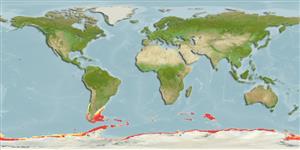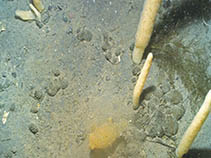Distaplia cylindrica (Lesson, 1830)
Sea rod| Native range | All suitable habitat | Point map | Year 2050 |

|
| This map was computer-generated and has not yet been reviewed. |
| Distaplia cylindrica AquaMaps Data sources: GBIF OBIS |
Classification / Names Common names | Synonyms | CoL | ITIS | WoRMS
Ascidiacea | Aplousobranchia | Holozoidae
Environment: milieu / climate zone / depth range / distribution range Ecology
Sessile; depth range 0 - 1000 m (Ref. 3435). Polar
Distribution Countries | FAO areas | Ecosystems | Occurrences | Introductions
Southwest Atlantic, Southeast Pacific and the Antarctic: From Antarctica to South America.
Length at first maturity / Size / Weight / Age
Maturity: Lm ? range ? - ? cm Max length : 8.0 cm COLD male/unsexed; (Ref. 3373)
Maximum depth from Ref. 3373. Colony is up to 700 cm long and 8 cm in diameter (Ref. 3373). Found on soft bottom substrates, weakly attached to mud, and on moraine deposits at a depth of 30 m (Ref. 1753), and even on rocky bottoms and prefer areas with a little current when they reach a considerable height (Ref. 87801).
Life cycle and mating behavior Maturity | Reproduction | Spawning | Eggs | Fecundity | Larvae
Members of the class Ascidiacea are hermaphroditic; both cross- and self-fertilization is typical. Life cycle: Eggs develop into lecithotrophic larva before metamorphosing into benthic adults.
Main reference
References | Coordinator | Collaborators
Tatian, M., R.J. Sahade, M.E. Doucet and G.B. Esnal. 1998. (Ref. 1753)
IUCN Red List Status (Ref. 130435)
CITES status (Ref. 108899)
Not Evaluated
CMS (Ref. 116361)
Not Evaluated
Threat to humans
Human uses
| FishSource |
Tools
More information
Internet sources
BHL | BOLD Systems | CISTI | DiscoverLife | FAO(Publication : search) | Fishipedia | GenBank (genome, nucleotide) | GloBI | Gomexsi | Google Books | Google Scholar | Google | PubMed | Tree of Life | Wikipedia (Go, Search) | Zoological Record
Estimates based on models
Preferred temperature
(Ref. 115969): -1.8 - 6, mean -0.2 (based on 778 cells).
Price category
(Ref. 80766):
Unknown.



